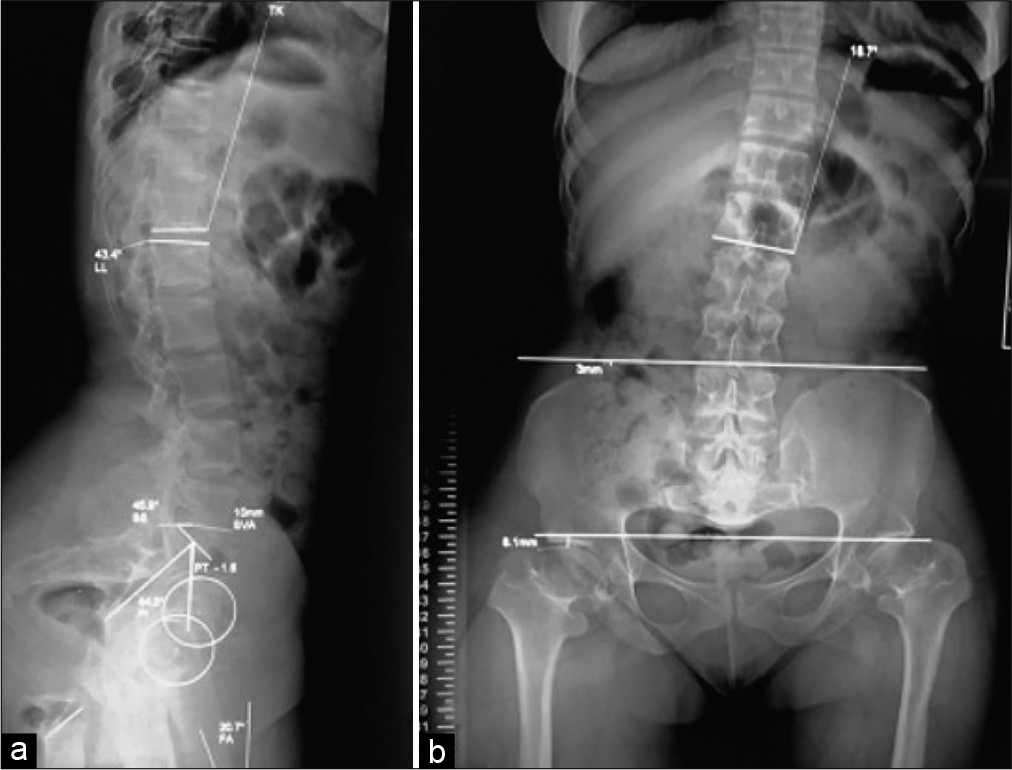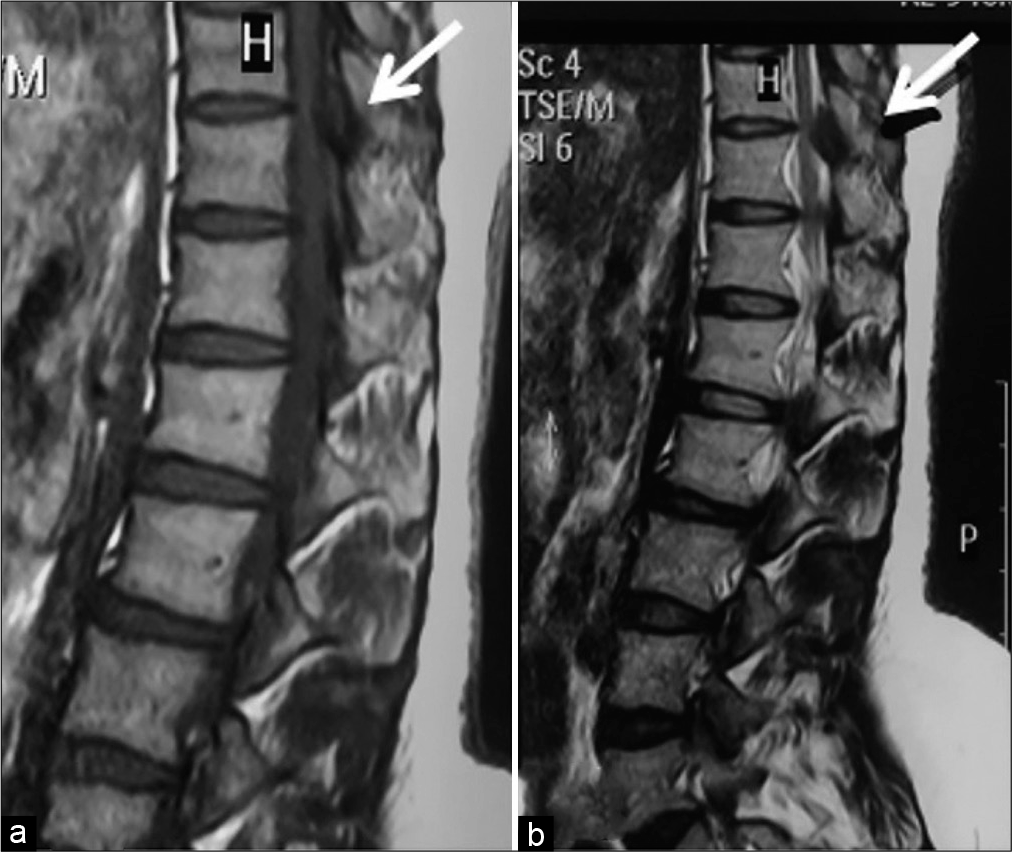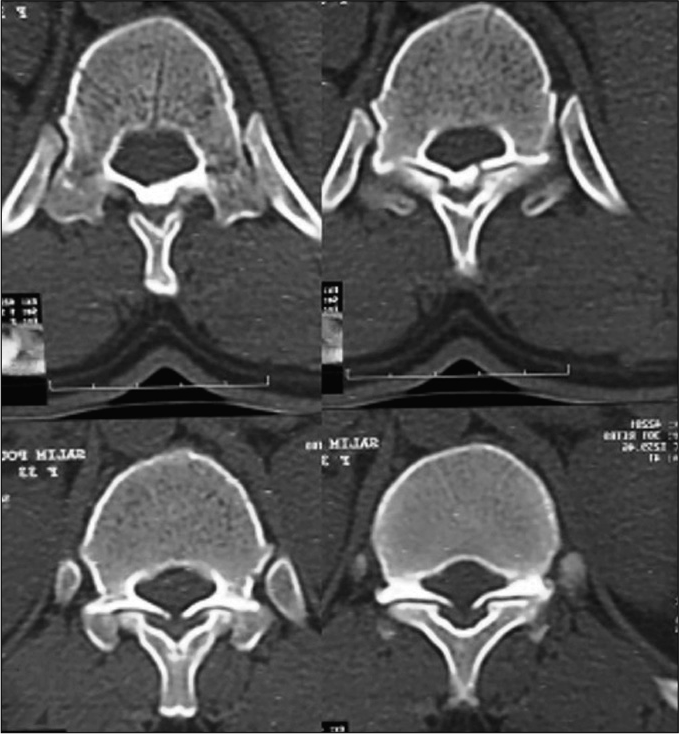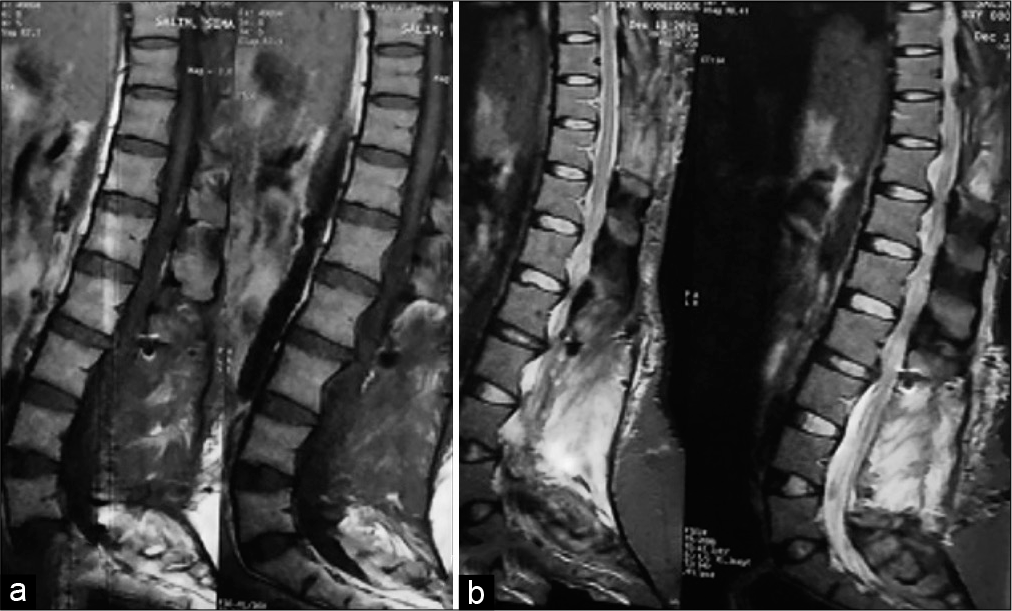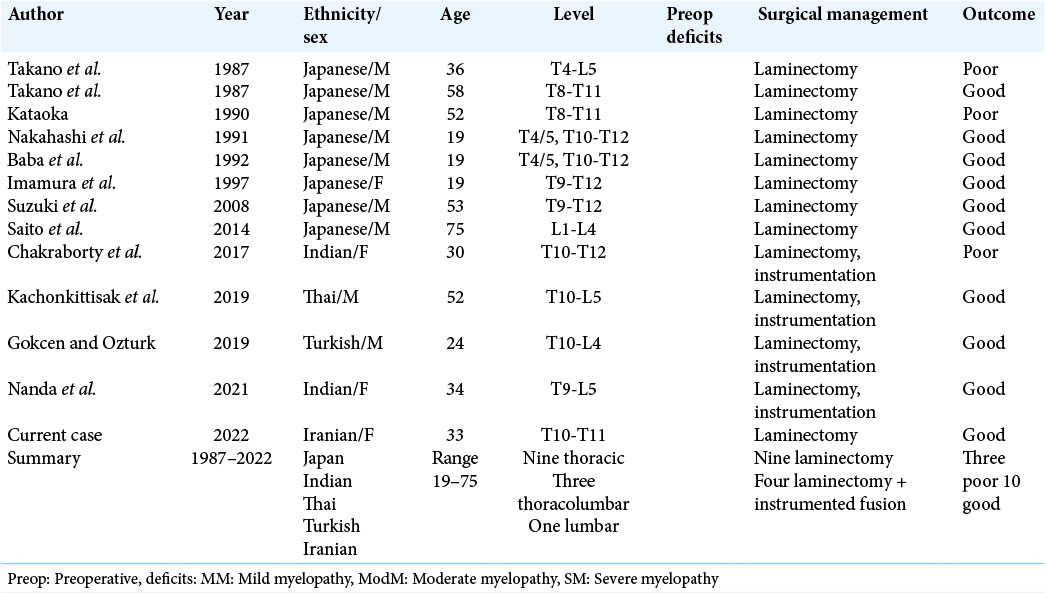- Pars Advanced and Minimally Invasive Medical Manners Research Center, Pars Hospital, Iran University of Medical Sciences, Tehran, Iran.
Correspondence Address:
Abolfazl Rahimizadeh, Pars Advanced and Minimally Invasive Medical Manners Research Center, Pars Hospital, Iran University of Medical Sciences, Tehran, Iran.
DOI:10.25259/SNI_101_2022
Copyright: © 2022 Surgical Neurology International This is an open-access article distributed under the terms of the Creative Commons Attribution-Non Commercial-Share Alike 4.0 License, which allows others to remix, transform, and build upon the work non-commercially, as long as the author is credited and the new creations are licensed under the identical terms.How to cite this article: Abolfazl Rahimizadeh, Sam Hajialiloo Sami, Mahan Amirzadeh, Shaghayegh Rahimizadeh, Naser Asgari. Symptomatic thoracic ossified ligamentum flavum in achondroplasia: A case report and literature review. 25-Feb-2022;13:70
How to cite this URL: Abolfazl Rahimizadeh, Sam Hajialiloo Sami, Mahan Amirzadeh, Shaghayegh Rahimizadeh, Naser Asgari. Symptomatic thoracic ossified ligamentum flavum in achondroplasia: A case report and literature review. 25-Feb-2022;13:70. Available from: https://surgicalneurologyint.com/surgicalint-articles/11411/
Abstract
Background: In a patient with achondroplasia, it is rare to encounter thoracic cord compression due to both spinal stenosis and ossification of the yellow ligament (OYL).
Case Description: A 33-year-old achondroplastic female presented with a progressive spastic paraparesis attributed to thoracic stenosis combined with T10-T11 OYL. Following a laminectomy, the patient demonstrated a marked recovery of neurological function.
Conclusion: This case and 12 others from the literature demonstrated that achondroplastic patients who present with myelopathy secondary to thoracic stenosis and OYL can be readily diagnosed with MR/CT and successfully treated utilizing decompressive laminectomies with/without fusions (i.e., for those crossing the thoracolumbar junction).
Keywords: Achondroplasia, Laminectomy, Lumbar canal stenosis, Ossification of the ligamentum flavum
INTRODUCTION
Ossification of yellow ligament (OYL) in the thoracic spine has only rarely been reported to result in severe myelopathy in achondroplastic patients with thoracic stenosis.[
CASE REPORT
A 33-year-old achondroplastic female presented with a progressive spastic paraparesis/unsteady gait of 6 months’ duration. In addition to the characteristic features of spinal achondroplasia on routine X-rays, the thoracolumbar MRI and CT studies confirmed the presence of moderate thoracic stenosis plus T10/T11 OYL (i.e., dorsolateral hypodense masses) [
Figure 1:
Total spine radiographs. (a) Posteroanterior radiograph shows large pedicle cortex outline, note the interpedicular distance progressively decrease from thoracic to the lumbar spine. Mild coronal imbalance is also seen. (b) Lateral views demonstrate short, large pedicles, and lumbar canal stenosis along with mild sagittal imbalance.
DISCUSSION
Ossification of the ligamentum flavum (OLF) is well-known that involves patients from all over the world, including Iran (i.e., the US).[
CONCLUSION
OLF should be considered among the differential diagnoses for achondroplastic patients with thoracic spinal cord compression and OYL. Following diagnostic MR/CT studies, these patients typically do well with laminectomies alone, only rarely requiring fusions.
Declaration of patient consent
The authors certify that they have obtained all appropriate patient consent.
Financial support and sponsorship
Nil.
Conflicts of interest
There are no conflicts of interest.
References
1. Epstein NE. Ossification of the yellow ligament and spondylosis and/or ossification of the posterior longitudinal ligament of the thoracic and lumbar spine. J Spinal Disord. 1999. 10: 250-6
2. Gokcen HB, Ozturk C. Ossification of the ligamentum flavum at the thoracic and lumbar region in an achondroplastic patient. World Neurosurg. 2019. 126: 461-5
3. Kachonkittisak K, Kunakornsawat S, Pluemvitayaporn T, Piyaskulkaew C, Pruttikul P, Kittithamvongs P. Congenital spinal canal stenosis with ossification of the ligamentum flavum in an achondroplastic patient: A case report and literature review. Asian J Neurosurg. 2019. 14: 1231
4. Nakahashi K, Baba H, Takahasi K, Kawahara N, Kikuchi Y, Tomita K. Achondroplasia with ossification of yellow ligament of the thoracic spine: Report of a case. Orthop Surg Traumatol. 1991. 34: 397-400
5. Nanda A, Bansal K, Gupta A, Verma K, Manghwani J, Chhabra HS. Multilevel thoracic and lumbar ligamentum flavum ossification in an achondroplasic-a rare presentation. Spinal Cord Ser Cases. 2021. 7: 69-9
6. Rahimizadeh A. Isolated proximal thoracic ossified ligamentum flavum causing paraparesis in a Caucasian: A case report and review of literature. World Spinal Column J. 2012. 3: 38-43
7. Rahimizadeh A, Asgari N, Soufiani H, Rahimizadeh S. Ossification of the cervical ligamentum flavum and case report with myelopathy. Surg Neurol Int. 2018. 9: 263
8. Rahimizadeh A, Habibollahzadeh P, Williamson WL, Soufiani H, Amirzadeh M, Rahimizadeh S. Symptomatic thoracic ossification of the ligamentum flavum in a patient with ankylosing spondylitis: Report of a case and review. Surg Neurol Int. 2021. 12: 596
9. Rahimizadeh A, Soufiani H, Amirzadeh M, Rahimizadeh S. Ossification of the ligamentum flavum of the lumbar spine in Caucasians: Case series. J Spine Neurosurg. 2017. 6: 5
10. Saito K, Miyakoshi N, Hongo M, Kasukawa Y, Ishikawa Y, Shimada Y. Congenital lumbar spinal stenosis with ossification of the ligamentum flavum in achondroplasia: A case report. J Med Case Rep. 2014. 8: 88
11. Sharma D. A rare case of ossification of ligamentum flavum presenting as dorsal myelopathy in achondroplasia. J Neurol Stroke. 2017. 7: 254
12. Suzuki K, Kanamori M, Nobukiyo M. Ossification of the thoracic ligamentum flavum in an achondroplastic patient: A case report. J Orthop Surg (Hong Kong). 2008. 16: 392-5


